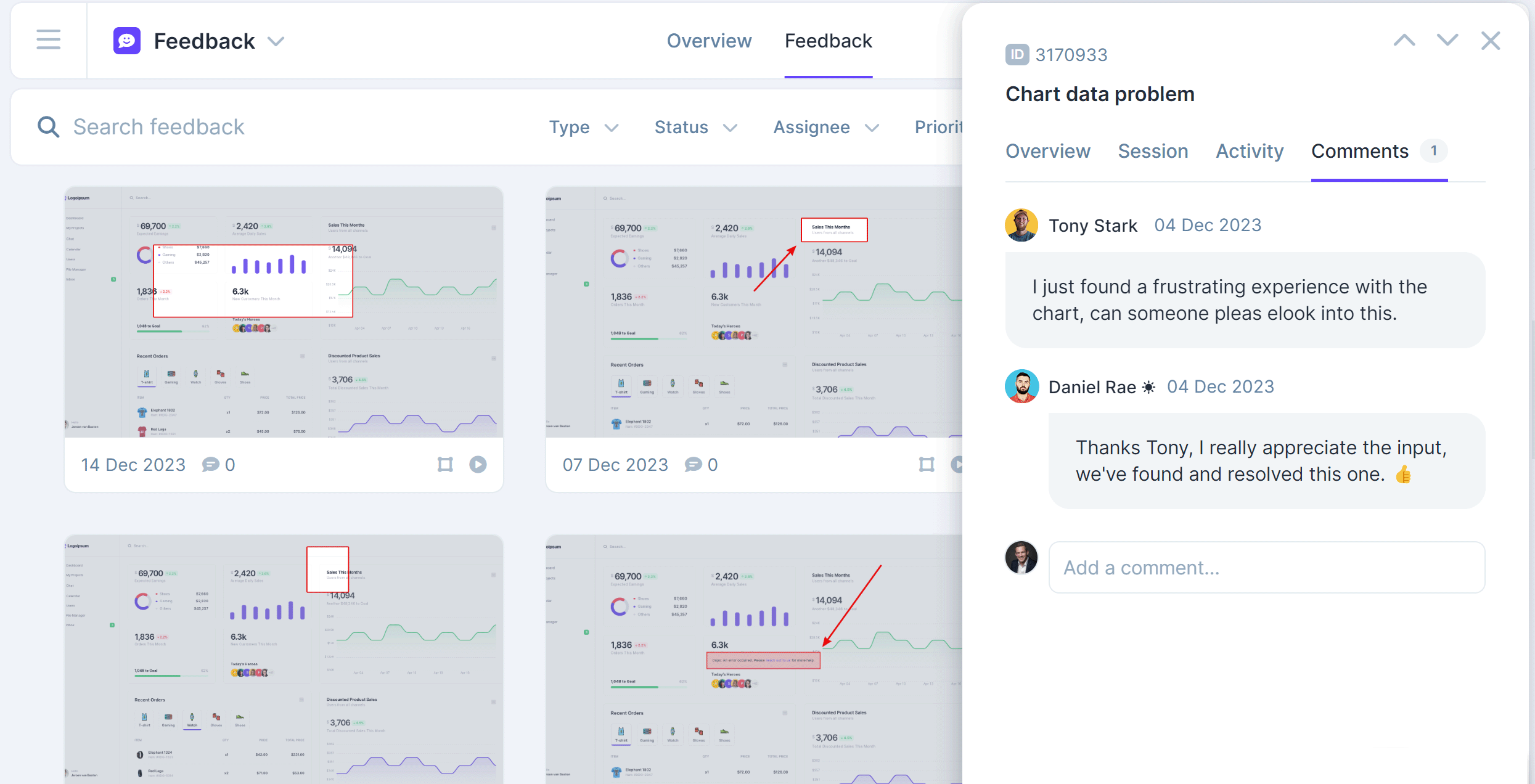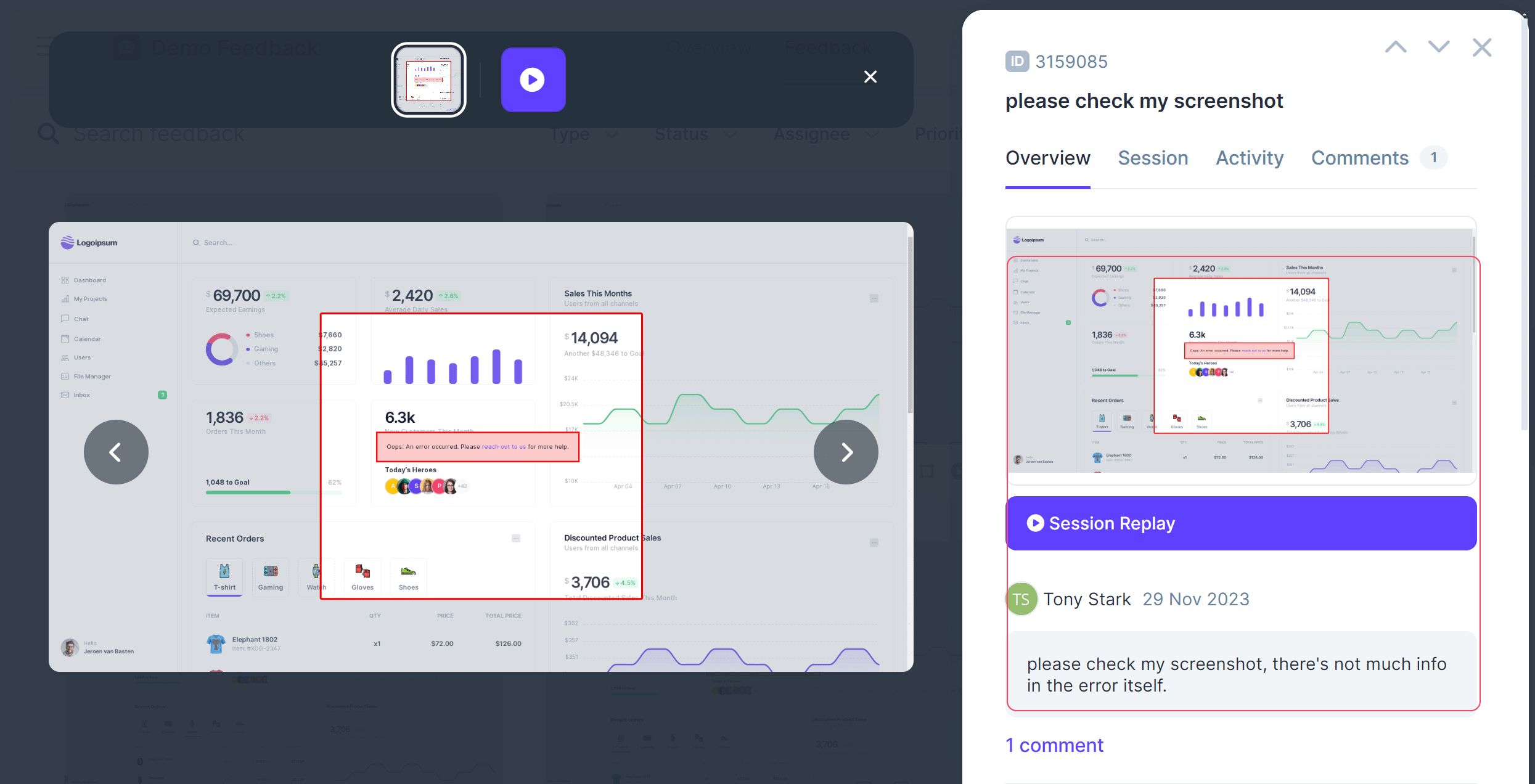
In the world of product development, the ability to quickly adapt and iterate is crucial and quality product feedback plays a vital role in driving this innovation and improvement. Effective feedback highlights areas for enhancement and guides the development team in creating user-centric solutions. It closes the gap between user expectations and product performance, ensuring exceptional final results. Without well-crafted feedback, teams might miss chances to enhance features that boost user experience. A continuous feedback loop is essential for competitiveness in fast-paced markets.
Why product feedback often goes unnoticed
Despite the critical importance of feedback, several obstacles often prevent it from being effectively utilized. One major pitfall is the lack of a structured channel for feedback collection and distribution. Without this, valuable insights can get lost or overlooked. Additionally, when feedback is not specific or actionable, it leaves the development team guessing how to make improvements, which can lead to misdirection or wasted efforts. Another significant issue is the timing of feedback; if it comes too late in the development process, making changes becomes more difficult and costly. Finally, a lack of openness and trust between stakeholders and product teams can hinder honest, constructive communication. Addressing these pitfalls requires a deliberate, solution-focused approach to systematize feedback and foster a culture of continuous improvement and open dialogue.
Understanding why feedback may be ignored or underutilized is essential to overcoming these obstacles and harnessing its full potential for product development success. Primarily, feedback can fall by the wayside due to its delivery in a format that isn’t actionable or specific enough, making it hard for teams to implement meaningful changes. Furthermore, a culture that doesn’t prioritize or value feedback can lead to it being dismissed or minimized, with teams possibly viewing it more as a critique than a constructive tool for enhancement.
Additionally, when feedback mechanisms are not integrated into the regular workflows or processes, they become an afterthought rather than a continual, integral part of the development cycle. Finally, the absence of a dedicated system for tracking and measuring the impact of feedback can result in missed opportunities for learning and improvement. Addressing these core issues with confidence and a solution-oriented strategy can transform feedback into one of the most powerful tools in a product team’s arsenal.
The pillars of actionable product feedback
Actionable feedback, the linchpin of progress, embodies several characteristics that distinguish it from generic observations. To create feedback that product teams and developers love, follow these five principles of great product feedback.
It’s specific; it pinpoints exact features or functions rather than offering broad generalizations, allowing teams to understand precisely what needs attention.
It’s objective; grounded in observable facts rather than subjective opinions, which facilitates unbiased improvement.
Solution-oriented; often accompanied by suggestions for improvement or examples of best practices. This approach shifts the focus from what’s wrong to how things can be improved.
It’s timely; given that there’s still ample opportunity to integrate changes without derailing the project timeline.
Constructive dialogue; is encouraged, opening channels for clarification and further discussion. This not only enhances understanding but also fosters a collaborative environment where feedback is seen as a tool for collective success rather than criticism.
Practical steps for your product feedback
Ensuring your product feedback is heard
Delivering feedback that not only captures attention but motivates action is an art underpinned by strategic communication. Here are essential steps to ensure your feedback resonates and leads to tangible improvements:
- Establish a constructive mindset: Begin by affirming your commitment to the project’s success and your role as a supportive collaborator. This sets a positive tone and primes your audience to receive your insights as opportunities for growth rather than criticism.
- Be direct yet respectful: Convey your points clearly and without ambiguity, but do so with respect and empathy. Understand that behind every project are individuals who have invested time and effort. Your feedback should recognize this effort even as it seeks to improve outcomes.
- Use the ‘sandwich’ method: Start with what’s working well to open on a positive note, then move on to areas of improvement, and finally, close with another positive note or a reaffirmation of the project’s potential. This approach helps maintain morale and keeps the focus on improvement.
- Provide evidence or examples: Make your feedback irrefutable by citing specific examples or data. This reinforces the relevance and urgency of your feedback, making it harder to ignore or postpone.
- Offer solutions, not just criticism: Whenever possible, accompany your feedback with practical suggestions for improvement. This demonstrates your commitment to resolving issues and transforms feedback from a problem into a solution.
- Follow up regularly: Feedback should not be a one-off activity. Establish regular check-ins to discuss the progress of implemented changes. This shows your ongoing commitment to the project’s success and ensures that feedback results in actionable outcomes.
By implementing these strategies, your feedback becomes a powerful catalyst for change, driving the kind of focused action that leads to meaningful and sustained improvements.

The role of team empathy in product feedback
Empathy plays a critical role in ensuring that product feedback is not only effective but also fosters a supportive environment for development teams to thrive. Understanding the team’s challenges and pressures is essential in tailoring your communication to be as impactful and constructive as possible. When you approach product feedback with empathy, you acknowledge the hard work and dedication that goes into the development process. This understanding allows you to frame your feedback in a way that is supportive and constructive, rather than dismissive or overly critical.
Empathetic communication ensures that product feedback is received as a means to collaborate towards a common goal, rather than as an adversarial critique. It helps to bridge the gap between identifying areas for improvement and motivating the team to action, recognizing the efforts and constraints they are operating under. By incorporating empathy into your approach, product feedback becomes a powerful tool for positive change, reinforcing trust and encouraging open dialogue.
Furthermore, empathy in delivering product feedback allows for a more nuanced understanding of the challenges faced by the development team. This understanding can lead to more targeted and meaningful feedback that directly addresses the core issues at hand, making the feedback not just heard, but acted upon. In essence, empathy transforms product feedback from a mere transaction of information to an engagement that enriches the product development process, fostering an environment where creativity, innovation, and productivity flourish.
Tools and techniques for efficient product feedback delivery
In product development, using modern tools and methods is crucial for clear communication between teams and stakeholders when looking at product feedback. Breaking down siloed feedback in the form of disconnected email, and a combination of spreadsheets is a critical step. No matter how articulate the feedback is, if your team never sees it, it’ll never impact your product for the better.
Teams should consider modern approaches like Userback that offer a centralized, and standardized method of collection, management, and closure of all feedback. Consider product feedback tools that support submission opportunities directly from your marketing website or web application to reduce friction, look for browser extensions to speed up internal types of feedback, and those that can add context to feedback with the ability to add visual and video elements (a picture is worth a thousand words after all). Modern tools attach the technical metadata and session replays to product feedback automatically to provide developers with everything they need to understand, recreate, and resolve issues and bugs up to 10X faster than the traditional methods. Additionally, users seeking long-term product feedback collection, or always-on feedback loops, should strongly consider tooling capable of creating categories of feedback for longer-term trends and statistical analysis.
The anatomy of good product feedback – A bug report example
It’s time to write a bug report that’s so helpful the developers will love you for it. To do so, your bug report must be clear, specific, and easy to understand. This way, the developers won’t struggle to understand your bug report. It makes it easier for them to locate and fix the bug. A general overview of what your bug report should cover includes:
- What. What has happened with the application?
- How. What did you do to produce the bug?.
- Where. Where in the app (environment) did you find the bug?
This is just a basic structure of a bug report, of course. There’s more that goes into writing a good one. And that’s what we’ll be looking at in this section.

1. Bug report title
Every strong bug report commences with a well-crafted title. Your bug report’s title plays a crucial role as it serves as the initial point developers encounter. A bug report title must be highly descriptive while maintaining brevity.
An effective bug report title facilitates developers in comprehending the issue, locating it swiftly, and discerning the steps necessary for resolution.
An inadequate example would be, “Shopping cart not working.” Although it points out the problem area, it lacks clarity and specificity regarding the issue. A superior title choice would be, “Cart — items added to cart don’t appear in the cart on desktop.”
Another recommendation for crafting a strong bug report title is to incorporate keywords, enhancing searchability.
2. Summarize and recap your product feedback
Sometimes the bug report title isn’t enough to explain the bug you’ve found. In this case, it would be a good idea to add a summary. Your summary must be concise, adding important information or context to what the title has already mentioned.
A good summary explains in brief what happened. Make sure to avoid including subjective opinions in your bug report summary. Instead, get to the point and highlight the technical issues concerning the bug.

3. Environmental insights make a huge impact
It’s no secret that websites and apps behave differently in different environments. That’s why, when writing a bug report, it’s essential to include the environment in which the bug was found. This could include, among others:
- Operating system
- Browser
- Screen size
- Pixel ratio
- Device type
Providing developers with all this information is vital for aiding them in reproducing the bug. Luckily, tools like Userback effortlessly capture most of the necessary information.
Without knowing the environment in which the bug manifests could lead to them failing to reproduce it. Remember, a good bug report is supposed to make it easy for developers to locate the bug. One of the best ways your report can succeed in doing so is to note the exact environment you found the bug.

4. Add visuals where possible
It’s a smart move to enhance your bug report with visuals. While numerous tools can record your screen, visual bug reporting tools help your product feedback stand out as you replicate bugs. A good bug tracking and feedback tool should enable anyone to provide screen recordings, screenshots, and annotations for clearer bug comprehension by developers. Visual bug reporting accelerates the bug reporting process effectively.
5. Compare actual results to expected results
A crucial aspect of a solid bug report involves comparing the actual outcomes with the expected ones. Here, you record the application’s intended functionality and its current performance.
6. Steps to reproduce the bug
Having detailed the bug and demonstrated the issue to developers, the crucial next step in your bug report involves outlining how to reproduce the bug. This step is vital as developers need to encounter the bug themselves to gain a deeper understanding of it.
When outlining the steps developers must take to reproduce the bug, make sure to be:
- Precise
- Comprehensive
- Logical
It also makes it easier for the developers if you use a numbered list to outline the steps needed to reproduce the bug. This makes it easier to follow the process that triggers the bug. Also, it’s a good idea to reproduce the bug several times and note the reproducibility rate.
7. Bug Severity and Priority
Other important elements of a good bug report are the severity of the bug and the priority with which the bug must be attended to. Let’s break these two down and see how you can include them in your bug report.
Bug Severity
This is a measure of how much impact the bug has on your product. It’s usually rated from minor (where the bug doesn’t affect functionality) to critical (where the bug makes your product unusable). Depending on the scale you use within your team, make sure to note the severity of the bug in your report.
Bug Priority
Priority refers to the urgency with which the bug should be attended to. For example, if the bug affects functionality, then it must be given high priority. A bug that affects a non-critical component of your application, on the other hand, is a low priority bug.
As a tester, you must help the development team work faster by letting them know both the bug’s severity and the priority with which it must be resolved.
8. Include the Source URL
An essential but often overlooked piece of information when writing a bug report is the source URL. Including it in your bug report will help developers head to the problem page fast. It saves a lot of precious time, and they’ll love you for including it in your report.
Developing a Culture of Continuous Improvement Focused on Good Product Feedback
Establishing efficient feedback loops within the product development process is not just beneficial—it’s essential for ensuring that products continually meet and exceed the expectations of users. By integrating regular, structured feedback mechanisms, teams can pivot quickly, make informed decisions, and enhance product quality with agility. This approach not only streamlines communication between developers, testers, and users but also fosters a culture of continuous improvement. Encouraging open dialogue and constructive criticism ensures that all voices are heard and that product iterations are in direct response to real user needs and challenges. Remember, in the fast-paced world of product development, the ability to adapt and evolve based on user feedback is a key determinant of success. Embrace feedback loops as a powerful tool for driving continuous improvement and delivering exceptional products that meet the ever-changing needs of users.
Cultivating an environment where product feedback is not just welcomed but eagerly pursued can transform the way teams develop, refine, and enhance their offerings. Here are some tips for fostering such an environment:
- Establish Clear Channels for Product Feedback: Ensure that there are accessible, straightforward ways for users and team members to give feedback. This could include feedback forms, dedicated email addresses, or forums. Making the process easy and intuitive encourages more people to share their insights.
- Celebrate Product Feedback: Make it known that feedback is valued by publicly acknowledging the contributions of those who offer constructive criticism. This could be through shout-outs in team meetings, highlights in newsletters, or recognition on social media platforms. Celebrating feedback demonstrates to your team and users that their input directly influences the product’s evolution, making them more likely to contribute in the future.
- Act on Product Feedback: It’s critical to not only collect feedback but to act on it. When users see their suggestions being implemented, they feel a part of the product’s growth, which in turn, bolsters their engagement and loyalty. Make it a habit to regularly review feedback, prioritize actionable items, and integrate changes where feasible. Additionally, update your community about how their feedback has led to improvements. This closes the loop and reinforces the value of their contribution.
By implementing these strategies, teams can ensure that product feedback is not only sought after and received but acts as a catalyst for continuous product improvement and innovation.
Conclusion
The essence of crafting unignorable product feedback lies in its power to catalyze significant improvements and innovations. By thoroughly documenting bugs, incorporating environmental details, utilizing visuals, comparing actual versus expected results, and delineating reproducible steps, we equip development teams with invaluable insights. Such detailed feedback not only emphasizes the issues but underscores their impact, compelling teams to take swift, focused action. This practice not only elevates product quality but also ensures that products evolve in alignment with user needs and expectations, fostering a culture of excellence and continuous advancement.
The importance of adopting a solution-focused approach to product feedback cannot be overstated. Such a mindset not only accelerates product improvement but also significantly nurtures team development. Remember, product feedback is not just about identifying what’s wrong; it’s about collaboratively finding the right fix to drive your product forward. By viewing feedback through a submitter AND receiver-oriented lens, your team can unlock a treasure trove of insights that lead to innovative enhancements, faster fixes, and, ultimately, a superior user experience.
